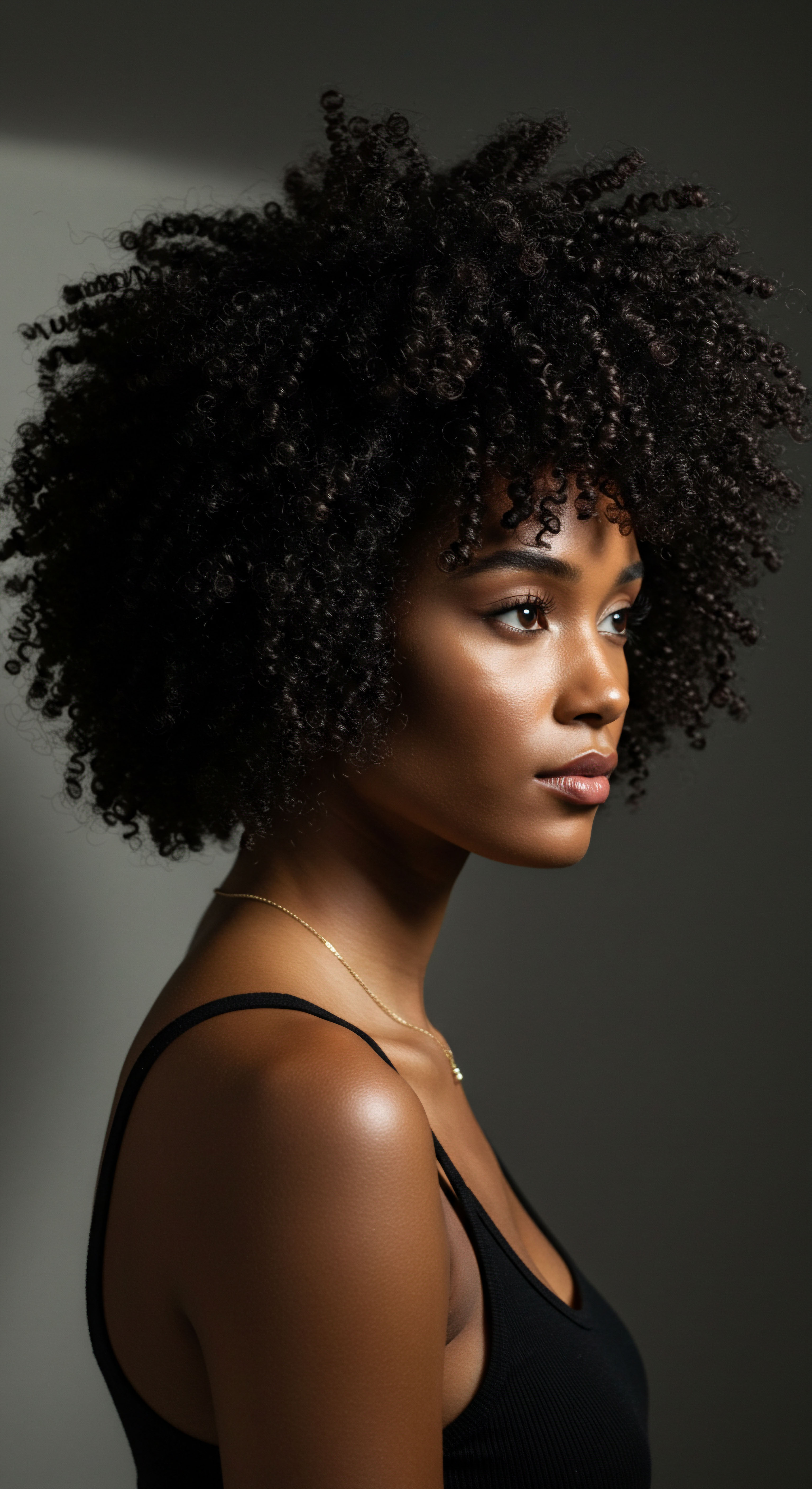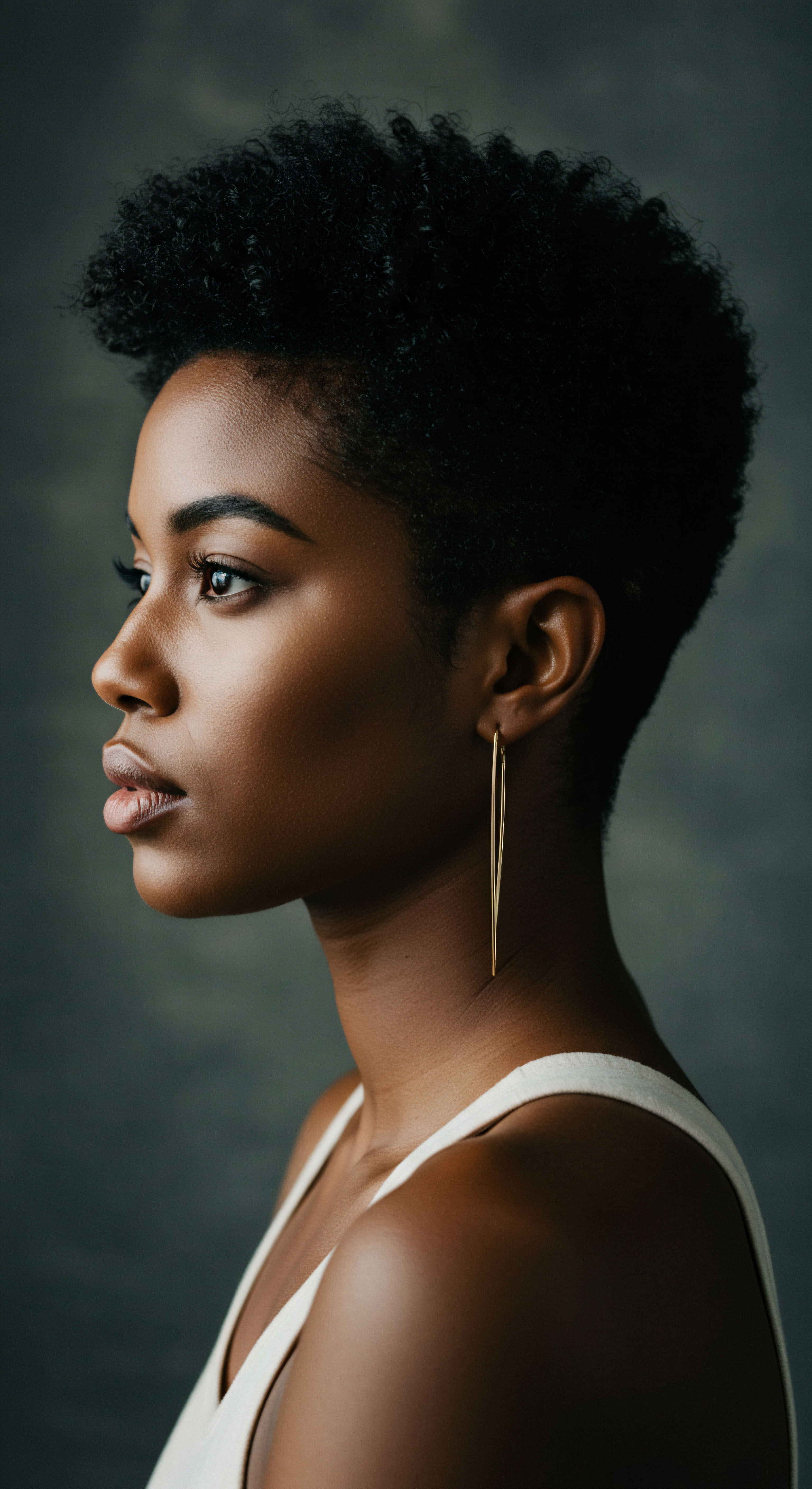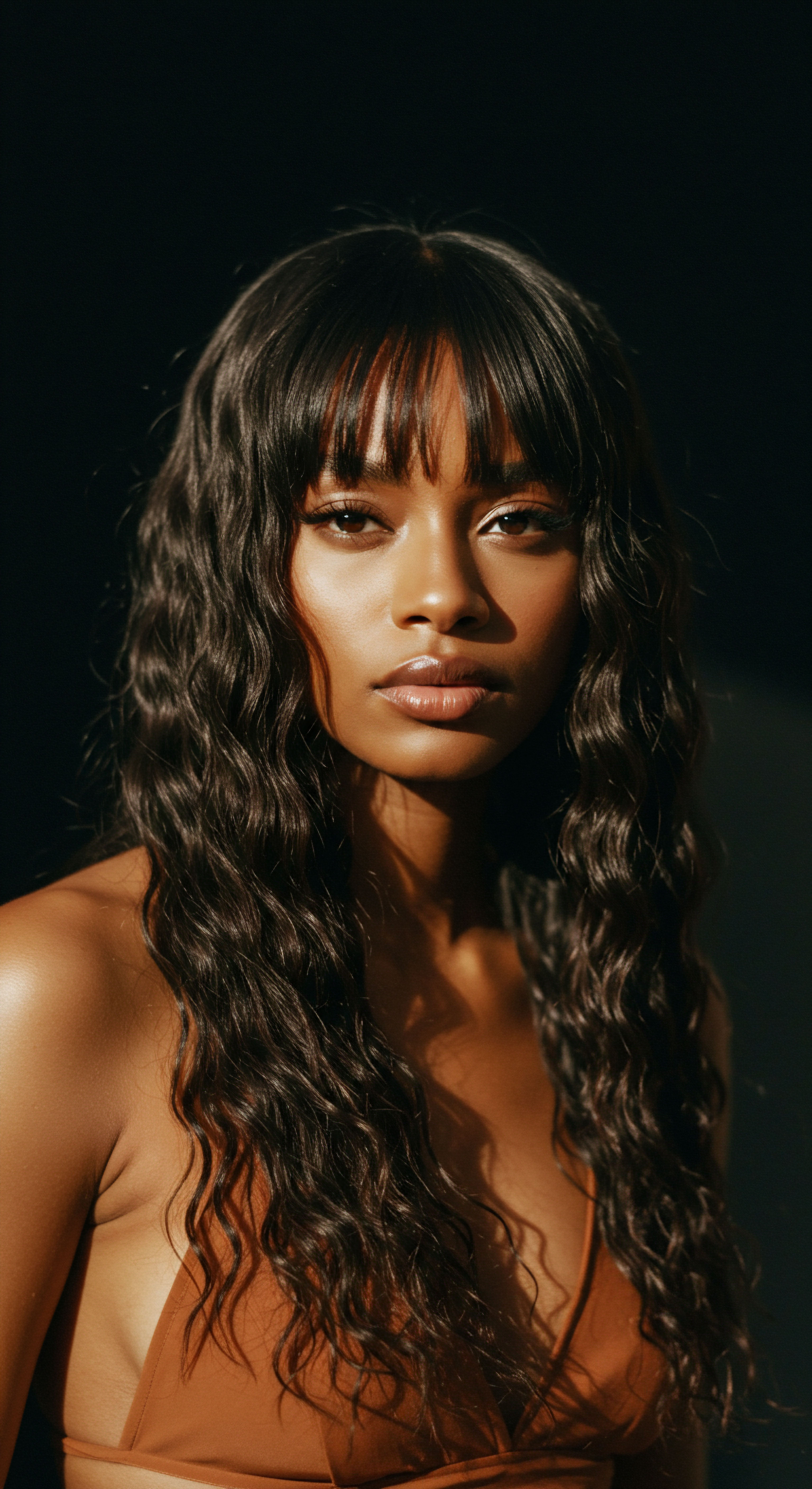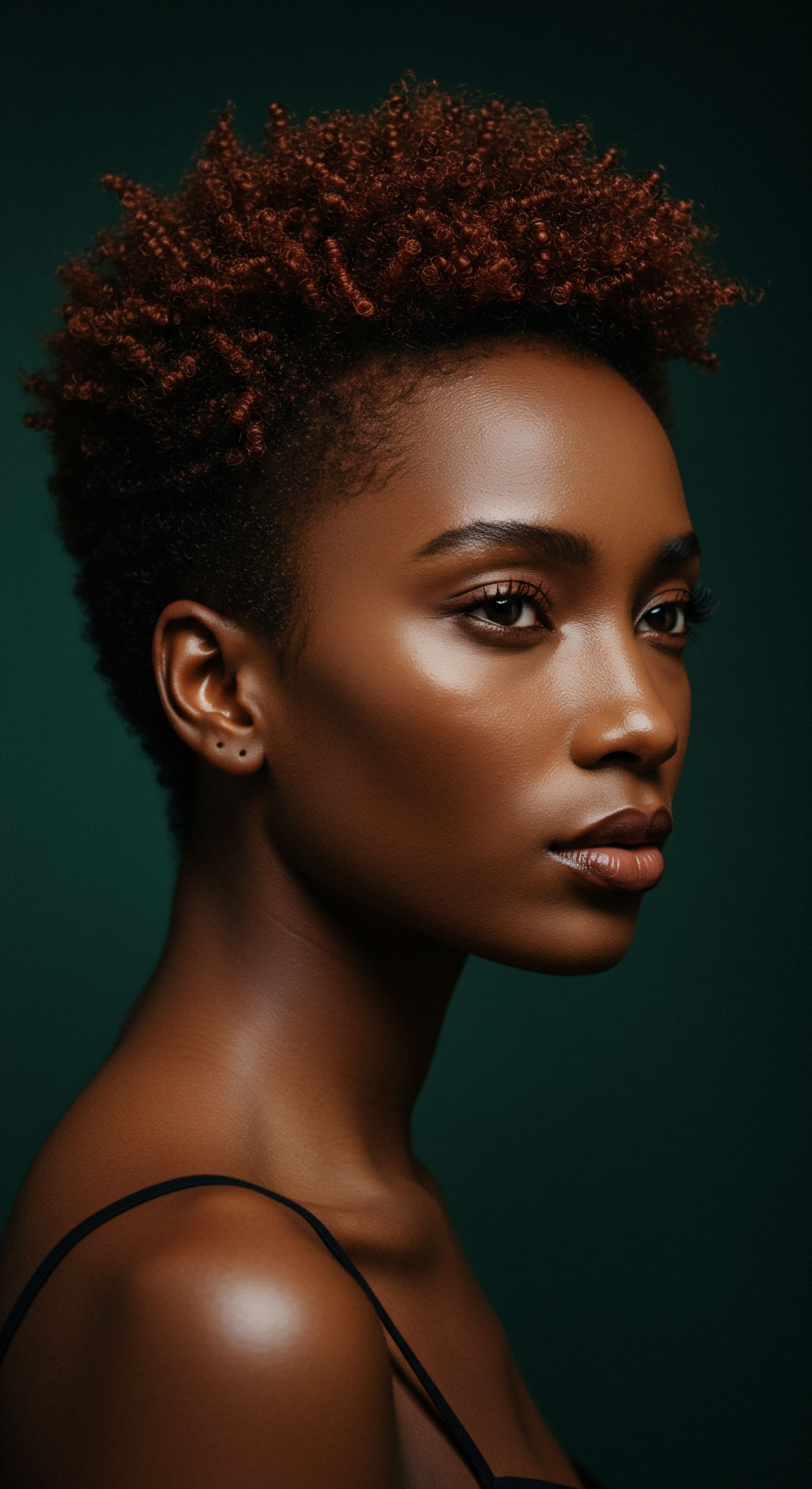
Roots
The quiet rustle of leaves, the gentle whisper of wind through tall grasses – these are the subtle beginnings of any deep inquiry. Similarly, when we consider the many meanings behind the protection of textured hair, we begin not with grand pronouncements, but with the very fibers themselves, with the foundational elements that lend this hair its unique character. It is a journey inward, to the cellular structures and growth patterns that distinguish it, before we venture outward to the rich cultural landscapes it shapes.
A strand of textured hair is a marvel of biological artistry, distinct in its helical construction, its varying degrees of curl, coil, or wave. Unlike straight hair, which typically possesses a round or oval cross-section, textured hair often exhibits a flatter, ribbon-like, or elliptical shape. This particular form, combined with the way keratin proteins bond, creates the characteristic bends and spirals. These curls mean that the outer cuticle layer, which shields the inner cortex, does not lie as smoothly.
Instead, it is lifted at various points, leaving the hair more susceptible to moisture loss and physical manipulation. This inherent structural difference underscores the particular need for gentle care, for methods that honor its delicate architecture rather than striving to force it into a different configuration.
Understanding the classifications of textured hair offers a language for its varied expressions. While no system fully captures the boundless diversity, common categorizations often divide hair into types 2 (wavy), 3 (curly), and 4 (coily), with further subdivisions based on the tightness of the pattern. These classifications are not rigid boxes, but rather descriptive guides, helping individuals identify their hair’s general tendencies.
For instance, a Type 4C Coil, known for its tight, Z-patterned curl, may present different needs than a looser Type 3A curl, often seen as a broad S-pattern. This shared lexicon permits a more precise dialogue around hair health and styling, allowing for a deeper appreciation of individual hair traits.
The vocabulary surrounding textured hair extends beyond simple classifications. Words like Porosity, referring to the hair’s ability to absorb and hold moisture, become central to effective care. High porosity hair, with its more open cuticles, may quickly take in water but just as quickly release it, requiring different product choices than low porosity hair, which resists water penetration.
Similarly, understanding Elasticity, the hair’s ability to stretch and return without breaking, guides handling and styling choices. These terms, while seemingly scientific, become part of a practical wisdom passed down through generations, adapted and refined with modern knowledge.
The hair growth cycle, a universal biological rhythm, plays out uniquely on textured strands. The anagen (growing), catagen (transitional), and telogen (resting) phases influence hair density and length. Factors such as nutrition, stress, and genetics significantly affect these cycles.
For many with textured hair, perceived slower growth often relates to shrinkage, where the curl pattern compresses the actual length of the hair, making it appear shorter than it truly is. This optical phenomenon, rather than a slower growth rate, highlights the importance of protective styles that preserve length and minimize breakage, allowing the hair to reach its full potential.
The physical structure of textured hair, with its unique curl patterns and lifted cuticles, inherently calls for a mindful approach to its care, emphasizing moisture preservation and gentle handling.

What Distinguishes Textured Hair from Other Types?
The core distinction lies in the shape of the hair follicle itself. Instead of a round follicle that produces straight hair, textured hair emerges from an oval or even flattened follicle. This shape dictates the curvature of the hair strand as it grows, creating the signature bends, twists, and coils. The greater the ovality or flatness of the follicle, the tighter the curl pattern tends to be.
This structural variation affects how oils travel down the hair shaft, making textured hair generally drier at the ends compared to straight hair, which often receives natural oils more readily from the scalp. This anatomical difference is not a deficit, but a design that demands specific attention to hydration and protective measures.
Another distinguishing element involves the distribution of disulfide bonds within the hair’s cortex. These bonds are the chemical links that provide strength and shape. In textured hair, these bonds are not evenly distributed along the length of the strand, contributing to areas of fragility at the bends and twists.
This unevenness makes textured hair more prone to breakage if handled roughly or if its moisture balance is compromised. The inherent delicacy at these points necessitates techniques that minimize friction and pulling, promoting longevity and strength.
| Hair Type Type 2 Wavy |
| Visual Pattern S-shaped waves, from loose to defined |
| General Characteristics Can range from fine to coarse, prone to frizz |
| Primary Care Needs Lightweight moisture, frizz control, definition |
| Hair Type Type 3 Curly |
| Visual Pattern Looser spirals to tight corkscrews |
| General Characteristics Often has body and bounce, can be prone to dryness |
| Primary Care Needs Hydration, curl clump formation, minimal manipulation |
| Hair Type Type 4 Coily |
| Visual Pattern Tight coils, zig-zag patterns, often shrinks significantly |
| General Characteristics Most prone to dryness and breakage, high density possible |
| Primary Care Needs Intense moisture, protective styling, gentle detangling |
| Hair Type Understanding these types aids in selecting appropriate products and techniques. |

How Does Hair Anatomy Influence Protection Rituals?
The anatomical specificities of textured hair directly shape the protective practices observed within communities. For instance, the lifted cuticle layers and the tendency for dryness mean that moisture retention becomes paramount. This biological reality underpins the widespread use of humectants and emollients in conditioners and stylers, as well as the layering of products, often referred to as the “LOC” or “LCO” method (Liquid, Oil, Cream or Liquid, Cream, Oil). These methods are not arbitrary but are a direct response to the hair’s natural inclination to lose water, ensuring that moisture is sealed within the strand.
- Low Porosity Hair ❉ May benefit from lighter products and heat to aid absorption.
- High Porosity Hair ❉ Often needs heavier butters and oils to seal in moisture.
- Fine Strands ❉ Can be weighed down by too much product, requiring a delicate balance.
- Coarse Strands ❉ Can tolerate richer, denser formulations for deep conditioning.
Moreover, the fragility at the bends of coiled and kinky hair dictates the avoidance of excessive heat and harsh brushing. Tools like wide-tooth combs and fingers are favored over fine-tooth combs, and heat application is approached with caution, if at all. These are not merely preferences; they are learned responses to the hair’s structural vulnerabilities, developed over time to maintain its health and integrity. The cultural practices of protecting textured hair are, in essence, a practical application of its unique biology.

Ritual
As we move from the elemental truths of hair structure, our focus turns to the rhythms of care, the deliberate actions that bring life and resilience to textured strands. This section offers a gentle invitation into the world of daily and periodic practices, reflecting on the hands-on wisdom that shapes our connection to hair. It is here, in the quiet moments of preparation and styling, that science meets tradition, creating a profound understanding of what it means to truly nurture textured hair.
The practice of protecting textured hair extends far beyond simple aesthetics; it is a ritualistic act deeply tied to preserving the physical health of the hair. Protective Styling, a cornerstone of textured hair care, involves arranging hair in ways that minimize manipulation, shield ends from environmental damage, and reduce breakage. Styles such as braids, twists, buns, and cornrows serve a practical purpose ❉ they keep the hair tucked away, reducing exposure to friction from clothing, harsh weather, and constant handling.
This sustained protection permits length retention, allowing hair to grow without the constant setback of breakage. Beyond their functional aspects, these styles are often expressions of artistry, passed down through generations, each pattern carrying its own history and communal significance.
Natural styling techniques, aimed at defining and enhancing the hair’s inherent curl or coil pattern, form another significant component of this care. Methods like wash-and-gos, twist-outs, and braid-outs allow the hair to be worn openly, celebrating its natural shape. The careful application of specific products, from leave-in conditioners to gels and creams, helps to clump curls, reduce frizz, and hold definition.
This process is often a dialogue with the hair, observing how it responds to different products and techniques, learning its unique requirements for vibrancy. The act of seeing one’s curls fully formed and celebrated can be a powerful affirmation of self, extending beyond mere appearance.
Protective styles and natural hair definition methods are not just about looks; they are acts of preservation, guarding textured strands from environmental harm and encouraging their natural growth.

What Is the Cultural Significance of Protective Styles?
Protective styles hold layers of cultural significance, acting as visual markers of identity, heritage, and sometimes, resistance. Historically, many of these styles served as indicators of marital status, age, tribal affiliation, or social rank within various African communities. Braids, for example, could signify wealth or readiness for marriage.
As people of African descent were dispersed globally, these traditions persisted, often adapted and maintained despite oppressive attempts to erase them. The continuation of these styles became an act of quiet defiance, a way to hold onto a piece of one’s ancestral past in new, often hostile, environments.
In contemporary contexts, protective styles remain potent symbols. They represent a connection to heritage, a declaration of cultural pride, and a rejection of Eurocentric beauty standards that historically deemed textured hair unprofessional or unkempt. The act of wearing braids or locs, for instance, can be a statement of self-acceptance and a challenge to societal norms. This is not merely a trend but a reaffirmation of beauty that resides in authenticity and cultural continuity.
- Braids ❉ Varying patterns can signify community, status, or celebration.
- Locs ❉ Represent a journey of self-acceptance, spirituality, and natural growth.
- Cornrows ❉ Often a foundational style, with patterns holding historical and cultural meaning.

How Do Tools and Products Shape Hair Care Rituals?
The tools and products used in textured hair care are not simply commercial items; they are extensions of the ritual, each designed to address the specific needs of these hair types. Wide-tooth combs, often made of wood or specialized plastic, are essential for detangling, minimizing the pulling and breakage that finer-toothed combs can cause on coiled hair. Satin or silk bonnets and pillowcases, another common accessory, are used to reduce friction against cotton surfaces overnight, which can absorb moisture and create frizz, thereby preserving styles and preventing tangles. These items are not just about comfort; they are integral to maintaining hair health.
The selection of products also forms a significant part of the ritual. Conditioners, leave-ins, and moisturizing creams are central, chosen for their ability to hydrate and soften the hair, counteracting its natural tendency towards dryness. The ingredient lists are scrutinized, with a preference for natural oils, butters, and humectants. The growth of the textured hair care market itself speaks to this intentionality.
The global natural hair care products market is projected to reach USD 16.01 billion by 2029, with women with textured hair spending 78% more on products than those with straight hair on average. This economic reality reflects a deep commitment to finding formulations that honor and support the hair’s distinct requirements.
| Tool/Product Category Wide-Tooth Comb |
| Purpose Gentle detangling, minimizing breakage |
| Cultural/Practical Connection A mindful approach to hair's delicate structure, favoring preservation over force. |
| Tool/Product Category Satin/Silk Bonnet |
| Purpose Reduces friction, retains moisture overnight |
| Cultural/Practical Connection A nightly ritual of protection, safeguarding hair from environmental aggressors. |
| Tool/Product Category Deep Conditioner |
| Purpose Intense hydration and nourishment |
| Cultural/Practical Connection A consistent commitment to replenishing hair's moisture, vital for coiled patterns. |
| Tool/Product Category These items represent a thoughtful approach to maintaining hair health and integrity. |
The rise of dedicated product lines and brands specifically catering to textured hair signifies a powerful shift. It acknowledges that universal hair care solutions often fail to address the particular needs of coils and kinks. This recognition, spurred by consumer demand and a growing cultural pride, has led to a proliferation of specialized conditioners, styling creams, and scalp treatments. The ritual of selecting and applying these products becomes an act of self-care, a conscious decision to provide hair with what it truly needs to flourish, rather than attempting to alter its fundamental nature.

Relay
From the very roots of anatomical knowledge and the daily practices that bring hair to life, we now transition to a more expansive view, one that connects individual strands to broader societal currents. This section asks ❉ What profound cultural meanings truly lie within the act of protecting textured hair? It is a question that invites us to look beyond the surface, to consider how science, history, and personal experience converge in a complex interplay, revealing layers of identity, resistance, and self-determination. Here, we delve into the deeper implications, drawing upon research and lived realities to understand the enduring power held within these coils and curls.
The act of protecting textured hair is a statement, often silent yet undeniably strong, against historical and ongoing societal pressures. For centuries, Eurocentric beauty standards have dominated, frequently devaluing hair textures that do not conform to ideals of straightness or smoothness. This bias has not been merely aesthetic; it has permeated educational institutions, workplaces, and public spaces, creating environments where natural textured hair is deemed unprofessional, unkempt, or even distracting. The very act of choosing to wear and care for one’s natural hair, therefore, becomes a form of cultural affirmation, a quiet rebellion against imposed norms.
Consider the workplace, a realm where appearances are often scrutinized. A 2023 CROWN Workplace Research Study, co-commissioned by Dove and LinkedIn, found that Black Women’s Hair is 2.5 Times More Likely to Be Perceived as Unprofessional. This striking statistic is not just a data point; it represents countless instances of microaggressions, lost opportunities, and the psychological toll of feeling compelled to alter one’s appearance to fit into a biased professional landscape. The study also revealed that approximately two-thirds of Black women (66%) change their hair for a job interview, with 41% of those changing from curly to straight.
This reality underscores the deep-seated cultural expectation that natural hair must be tamed or hidden to attain professional success. Protecting textured hair, in this context, becomes an act of reclaiming authenticity and challenging systemic biases.
Protecting textured hair stands as a powerful cultural act, challenging deeply ingrained societal biases and affirming self-worth in the face of historical devaluation.

How Does Hair Protection Relate to Identity and Self-Acceptance?
The relationship between textured hair and personal identity runs deep. For many, hair is not simply an appendage; it is an extension of self, a visible connection to heritage and ancestry. The process of learning to care for one’s natural hair, particularly after years of chemical straightening or conforming to other beauty standards, can be a profoundly transformative experience.
It often involves a period of self-discovery, learning about one’s own hair type, its unique needs, and its inherent beauty. This journey can foster a heightened sense of self-acceptance and pride, as individuals reclaim a part of their identity that may have been suppressed or misunderstood.
The shared experiences of caring for textured hair also build community. Online forums, social media groups, and local gatherings dedicated to natural hair care create spaces for individuals to share tips, celebrate successes, and offer support. This communal aspect strengthens collective identity, reinforcing the idea that one’s hair, in its natural state, is not only acceptable but celebrated. The act of protecting textured hair, therefore, contributes to a larger cultural movement that redefines beauty standards and champions diversity.

What Is the Connection Between Hair Protection and Cultural Preservation?
The protection of textured hair is intrinsically linked to cultural preservation. Many styles, such as locs, braids, and twists, have roots in ancient African civilizations, carrying historical memory and ancestral knowledge. When these styles are maintained and passed down, they serve as living artifacts, connecting contemporary generations to their past. This continuity is not static; it evolves, incorporating modern techniques and expressions while retaining its historical resonance.
Beyond specific styles, the entire philosophy of protecting textured hair—emphasizing its strength, resilience, and unique qualities—counters a history of denigration. It is a conscious choice to prioritize hair health over conformity, a decision that speaks volumes about cultural self-worth. This stance has even translated into legislative efforts, such as the CROWN Act in the United States, which seeks to prohibit discrimination based on hair texture and protective styles in workplaces and schools. These legal protections acknowledge the profound cultural significance of hair and the necessity of safeguarding individuals’ right to express their identity without fear of prejudice.
The economic impact of the textured hair care market further highlights this cultural shift. The demand for specialized products, tools, and services has spurred a multi-billion dollar industry. This economic power supports businesses that understand and cater to the specific needs of textured hair, reinforcing the value placed on these hair types within their communities. It demonstrates that cultural preference, when asserted collectively, can drive significant market change, creating a positive feedback loop where cultural pride leads to economic empowerment, which in turn strengthens cultural identity.
- Ancestral Connection ❉ Many protective styles carry origins in African cultures, serving as a tangible link to heritage.
- Community Building ❉ Shared experiences in caring for textured hair foster strong bonds and collective identity.
- Economic Influence ❉ The demand for specialized products fuels a market that supports and validates textured hair.
The ongoing dialogue around textured hair, its care, and its place in society represents a broader societal conversation about acceptance, diversity, and equity. Protecting textured hair is not just about physical upkeep; it is about honoring a legacy, asserting identity, and contributing to a future where all forms of beauty are equally valued and respected.

Reflection
As the sun sets on our consideration of textured hair, a quiet truth remains ❉ its protection is far more than a regimen of creams and combs. It is a deep, resonating echo of history, a vibrant assertion of self, and a gentle act of defiance. The coils and curls, once targets of misunderstanding, now stand as symbols of resilience, of beauty reclaimed and celebrated. Each strand holds a story, a connection to lineage, and a whisper of strength that transcends fleeting trends.
To guard this hair is to guard a legacy, to honor a living tradition, and to affirm the rich, diverse tapestry of human identity. It is a soft revolution, carried out with care, with knowledge, and with an unwavering belief in the inherent splendor of every unique pattern.

References
- Mbilishaka, Afiya M. “Don’t Get It Twisted ❉ Untangling the Psychology of Hair Discrimination Within Black Communities.” American Journal of Orthopsychiatry, 2024.
- Harris, Clynessia, and Deanna R. Davis. “Wear Your CROWN ❉ How Racial Hair Discrimination Impacts the Career Advancement of Black Women in Corporate America.” Journal of Business Diversity, vol. 23, no. 2, 2023.
- Lisse, Adenique. “UConn Researcher Sheds New Light on Importance of Hair Satisfaction for Black Adolescent Girls.” Body Image, 2025.
- Johnson, Alexis McGill, et al. “The Good Hair Study ❉ Implicit and Explicit Attitudes Toward Black Women’s Hair.” Perception Institute, 2017.
- Maharaj, Claudette. “Beyond the roots ❉ exploring the link between black hair and mental health.” TRIYBE, 2025.
- Dove and LinkedIn. “2023 CROWN Workplace Research Study.” The CROWN Act, 2023.
- Syensqo. “The Future of Textured Hair Care Products.” 2023.
- Mintel. “Black Haircare Market Report.” 2018.